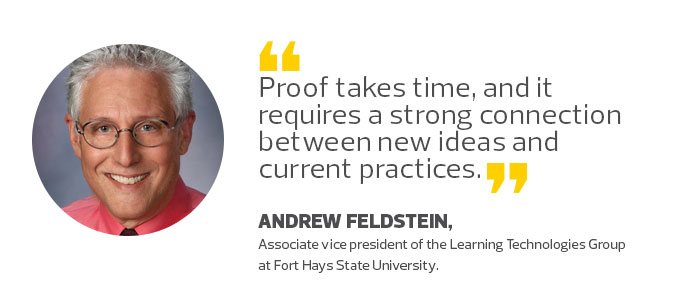To Help Innovations Take Root, Look Past Early Adopters on Campus
A few years ago, I attended a conference on open educational resources (OERs). At the time, I was a faculty member, working hard to implement an OER initiative at my college. The conference brought together stakeholders in a statewide OER strategy: faculty, administrators, IT leaders and legislators.
The first panel discussion focused on the classroom. It spoke clearly to my understanding of the issues related to OER creation and implementation. The second panel, which included two CIOs, focused on infrastructure.
What I remember about that second panel was my impatience with the issues the CIOs raised. Their concerns seemed a long way from mine, and I struggled to make the connection to what I saw as the issues for my college’s OER implementation. We’d gotten buy-in from a core of innovative faculty, but crossing to the mainstream was a struggle. I sought strategies to help us move forward, and I felt the CIOs had missed the point: to provide affordable resources to increase student success.
A Familiar Pattern of Implementation
Today, however, the proverbial shoe is on the other foot. As an IT administrator who has been a faculty member, one of my roles is to create a bridge between faculty and IT. I now understand those infrastructure concerns, but I am also acutely aware that early adopters among faculty and academic administrators are essential to the success of any learning technologies innovation.
Bridge building, in this context, is widely seen as a key strategy for a successful implementation. What I want to focus on, however, is not the bridge we know we have to build — the bridge between faculty and IT — but one that may be less obvious: the bridge between the early adopters and everyone else.
What these bridges have in common is the diffusion curve, one of the most widely acknowledged aspects of Rogers’ Diffusion of Innovations theory. It describes the pattern of adoption that people typically follow: innovators, early adopters, early majority, late majority and laggards. The theory says that each group watches the previous group to determine whether it will be worth their while to adopt a particular innovation.
Many adoption strategies rely on this “domino” interpretation of the diffusion curve. The idea is that capturing the imagination of early adopters and partnering with faculty opinion leaders will help to break down the resistance of subsequent groups along the curve.

Power in Numbers with New Digital Tools
However, my experience with the OER initiative suggests a different narrative. Early adopters — often characterized as revolutionaries, visionaries, risk takers and experimenters — represent about 15 percent of the population. The early majority and late majority are almost 70 percent. And they are more pragmatic, cautious, process-oriented and risk-averse, as William Geoghegan pointed out in “Whatever Happened to Instructional Technology?”
My own OER initiative stalled when we attempted to extend usage beyond early adopters. Writer and technology consultant Geoffrey Moore explains this challenge: An innovation’s promise may seduce early adopters, but the early majority requires proof that the innovation works. Proof takes time, and it requires a strong connection between new ideas and current practices.
Take the Long View for Creating New Platforms
So how do we build this bridge to the crucial early majority? A prudent course, even during the early stages, is to look past the early adopters to the majorities. As much as we value the role of early adopters, it would be ill advised to introduce a new platform that isn’t, as much as possible, consonant with existing processes and widely accepted pedagogy.
Revolutionary learning platforms might ignite the imagination of early adopters, but they also run the risk of alienating the majority for whom the innovation was intended. Making sure that any new learning platform has clear ties to existing processes and pedagogy will help to form necessary planks in that second bridge.









